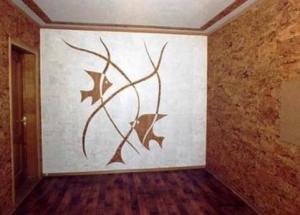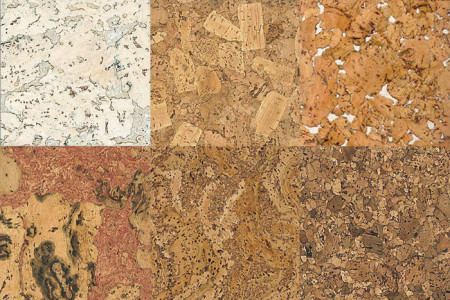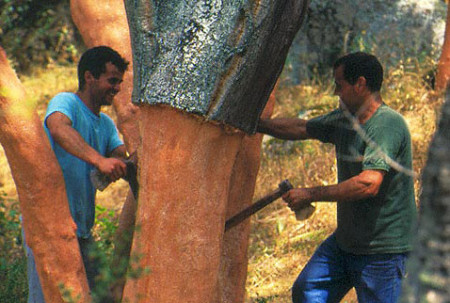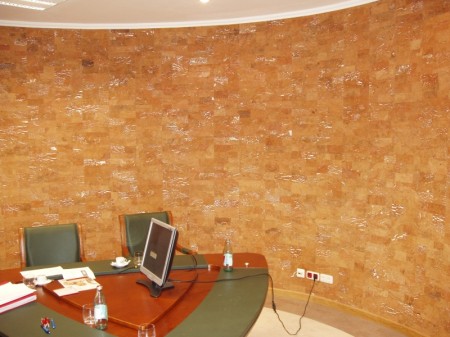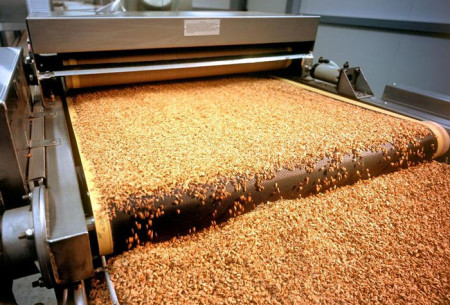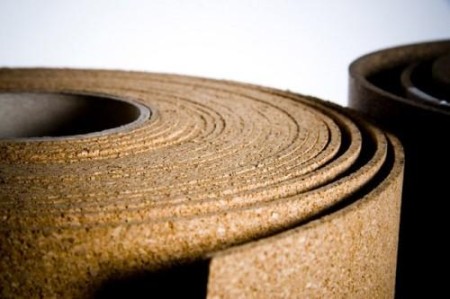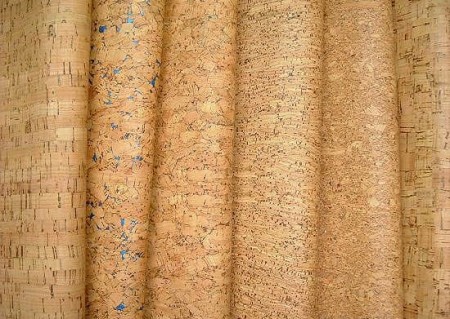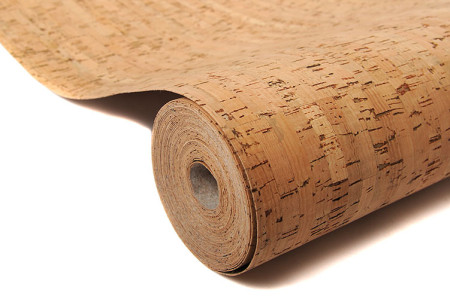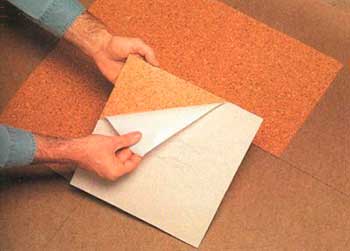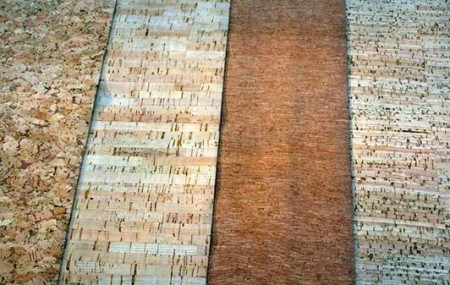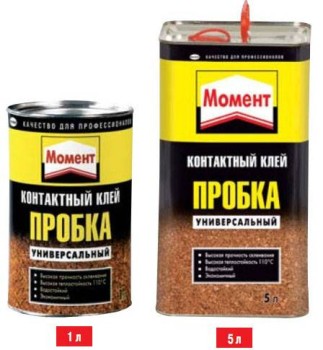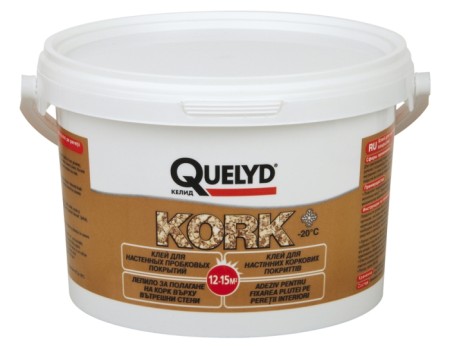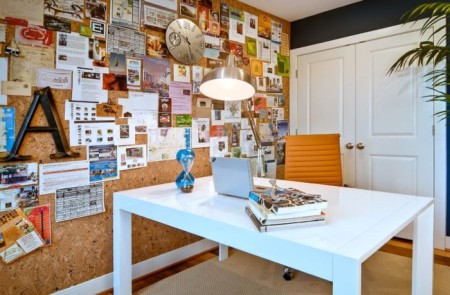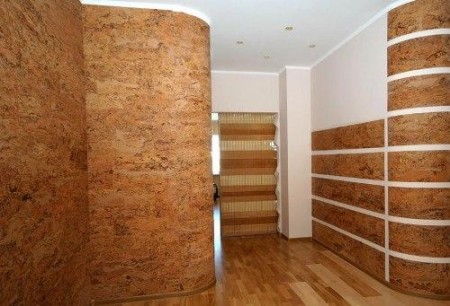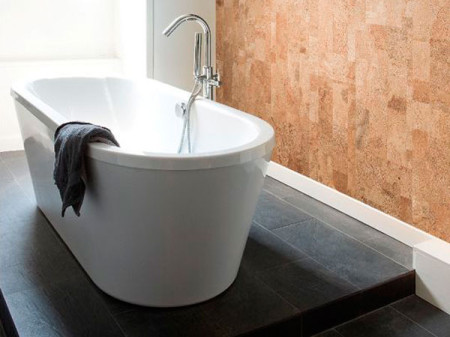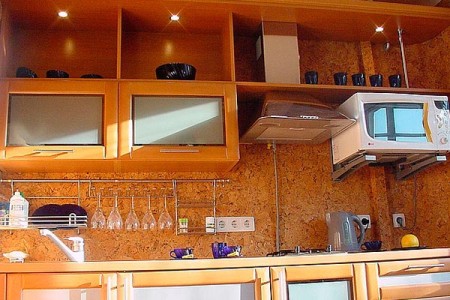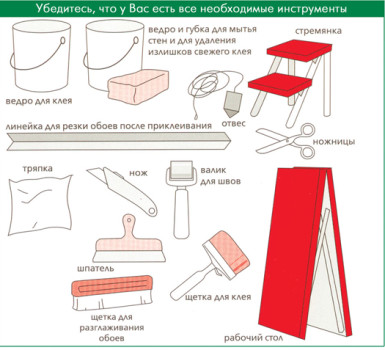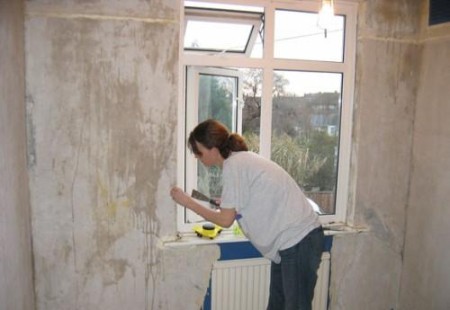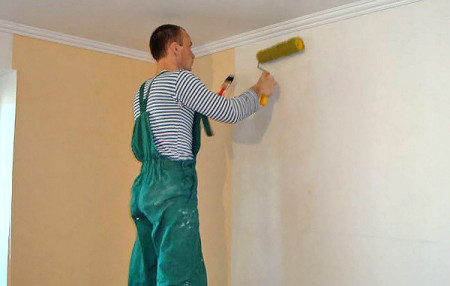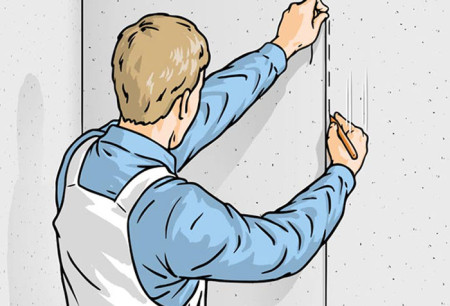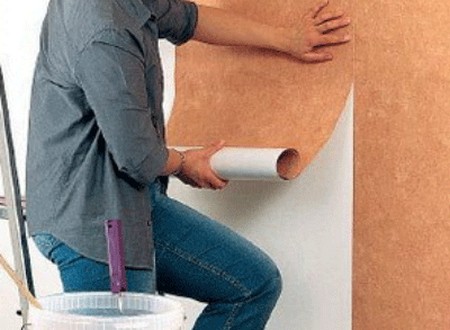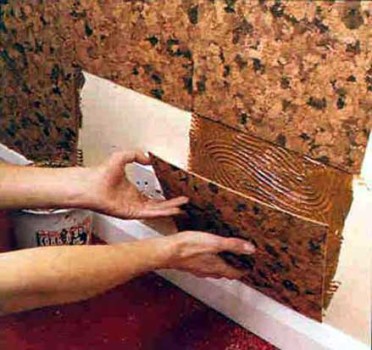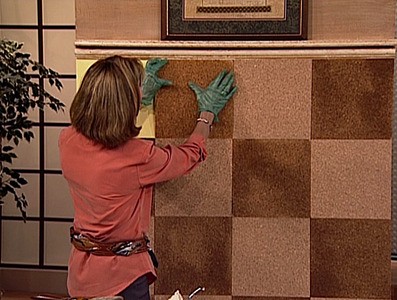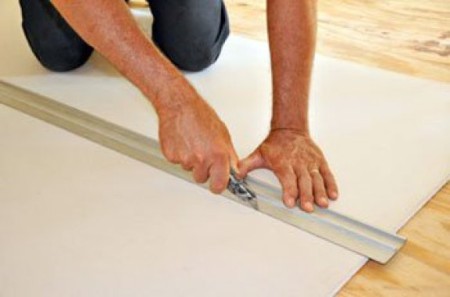Ecology, originality and beauty - this is not all that can be said about cork wallpaper. In the free sale, they appeared recently, and in a short time managed to conquer the customers with their novelty and uniqueness. Cork wallpaper creates in the room an indescribable cosiness and comfort, pleasing the owners of the house with its beauty and practicality. What are the advantages and disadvantages of cork wallpaper, what to look for when buying, how to properly glue cork wallpaper - read in our publication.
Content
What are cork wallpapers
Already from the very title it is clear which material is used for making wallpapers. Indeed, wallpaper is made on the basis of cork bark, which grows on the territory of several European countries - Portugal, Italy, Germany, Switzerland, and also in some African countries.
In the process of production, the bark is crushed, sent under the press, then a thin layer is applied to the paper substrate, or the crushed bark is used as an independent variant.
Sometimes cork wallpaper is confused with other finishing materials from the cork - for example, with cork panels or cork rolls. This is a mistake, since the cork panel consists entirely of pressed cork and veneer, and its thickness is 3 millimeters. Cork rolls are something that resembles slabs and wallpapers at the same time, their thickness is 2 millimeters.
Cork wallpaper: pluses and minuses
Cork wallpaper - in its own unique and universal material - their numerous advantages convincingly confirm this. This is an exceptionally natural and environmentally friendly finishing material, as in the production of wallpaper, either a treated cork is used in its pure form, or a cork pasted onto a paper substrate. Cork wallpaper can be safely glued in the children's room, in the kitchen - they do not emit absolutely no toxic substances. The surface of the cork wallpaper does not accumulate static electricity and dust - another plus for using them in children's rooms.
• The cork, thanks to its porous structure, perfectly silences extraneous sounds. Many remember that in Soviet times, apartments were often hung with carpets. This was done not for the sake of beauty, the carpet played the role of such a "soundproofing". Today, instead of this, which has already become archaic, "decorations" you can hang beautiful wallpaper, which, besides, will help you not to hear noisy neighbors and the sounds of a nearby busy highway.
• As you know, a tree is a warm material, and a cork is a real tree that can hold heat inside the building and not let it out, thus maintaining the best microclimate.
• The cork does not absorb odors, it burns very badly (even to some extent prevents the spread of fire), therefore, as already mentioned above, wallpaper is recommended for use in kitchens. If you cover the cork wallpaper with a layer of wax or varnish, they can be glued even in the bathroom.
• The cork is not easily affected by moisture and temperature changes, does not accumulate dust and dirt, is resistant to mechanical damage, it does not show fungus and mold. Hence another obvious plus of cork wallpaper - durability.
But, unfortunately, like any other finishing material, cork wallpaper is not without its drawbacks, which, incidentally, is not so much.
• The first and most obvious - cork wallpaper is more difficult to glue than usual. This is due, in the first place, to their greater weight.
• The surface for wallpapering must be carefully prepared, it must be clean and perfectly flat.
• Cork wallpaper is not distinguished by a wide range of colors and patterns - it's a natural material, and its color gamut is minimal. By and large, it is difficult to call it a disadvantage, but sometimes a scant choice of colors interferes with the implementation of some original design plans.
• High enough price - however, it is compensated by the durability of the finishing material.
• Cork wallpaper is quite strong material, however, they can be damaged by strong mechanical action or sharp objects, and since the material is expensive, you should treat it with care.
• On the surface of wallpaper, which will be used in the bathroom or in the kitchen, it is necessary to apply a water-repellent layer (wax or varnish).
Rules for choosing a cork wallpaper
In order to fully experience all the advantages of this kind of finishing materials, it is very important to pay maximum attention not only to the process of gluing, but also to the choice of cork wallpaper. The modern market can offer customers the following types of cork wallpaper:
Actually, natural cork wallpaper.
They are made from the crushed parts of the bark of the cork tree: under the press of the bark particles, an adhesive is released, and under the influence of high temperature, the crushed parts are glued together into a continuous web. Such a finishing material is completely natural, but it is very difficult to find, since the coating of this type does not enjoy too much demand.
Wallpaper of cork on a paper basis.
During the manufacturing process, the cork bark particles are applied to the paper with a very thin layer (1 mm). The wallpaper is very durable, it's much easier to work with, and if you decide to glue the cork wallpaper yourself, then this is the best option.
Cork wallpaper on a non-woven base.
Flizelin in its characteristics is very similar to ordinary paper, only more durable. This type of cork wallpaper is most preferable in terms of strength and ease of installation.
Very rarely, but still you can meet in the stores of building materials self-adhesive cork wallpaper. Their main advantage is that these wallpapers are suitable for any surface.
As for color and drawing, then, as already mentioned, the choice here is very small. Choose between several shades - from dark yellow to brown. However, in any case, the wallpaper from the cork will bring in any room warmth and comfort.
When choosing wallpaper from a cork, it is necessary to check the packaging for integrity. A good indicator - the availability of instructions for the installation and operation of cork wallpaper, indicating all the nuances, recommendations for the use of adhesive compositions, etc. Do not hesitate to ask the seller-consultant for certificates and documentation for the goods, which confirm its quality and safety.
Cork wallpaper - the type of product, when choosing which you need to pay attention to the type of adhesive composition, which is recommended for work. For example, all known PVA glue is not suitable, as it provides too little grip on the surface, and "liquid nails" "nails" the wallpaper too tightly - there will be problems with the dismantling.
It is recommended to choose a glue composition specially designed for cork wallpaper, or glue marks "Kelid", "Moment".
Cork wallpaper in the interior: for what rooms are suitable
As a universal finishing material, cork wallpapers are suitable for almost all types of living quarters. For example, for children's rooms, they are recommended because of its environmental friendliness and naturalness. However, do not forget that cork wallpaper - a thing expensive, and young children can spoil them. For bedroom and living room is a wonderful finishing material that contributes to the creation of inexpressible comfort and coziness.
Excellent cork wallpaper and for the hallway - they are not afraid of moisture, temperature changes, and small scratches on their surface are almost invisible.
Often cork for walls is used in bathrooms and kitchens - the cork is not afraid of moisture, does not absorb foreign smells, and is not a breeding ground for mold and fungus.
Cork wallpaper is easy to wash, but for bathrooms and kitchens you need a material with a wax coating, otherwise you will have to apply a layer of varnish on them yourself.
How to glue cork wallpaper
So, cork coverings for walls are realized in the form of rolls and plates. Both types of wallpaper are glued together almost equally. The following tools and materials will be needed for the job:
• Clean rag.
• Construction pencil.
• Construction level, or a plumb line.
• Sharp scissors or clerical knife with replaceable blades.
• A small spatula is needed to apply glue.
• Spatula-comb with a small tooth - also needed for applying glue.
• Wooden or metal ruler.
When choosing cork panels or wall cork, it is recommended to pay attention to their size. The wallpaper, which is realized in rolls, has a width of 30x60 cm or 30x100 cm. The length of the tape in the roll is 10 meters. The thickness of the cork wallpaper is about 3 mm. Cork panels are sold in standard sizes 30x30 or 60x60 cm. Given these parameters, it will be much easier to calculate the required amount of material, avoid unnecessary costs, or on the contrary - the need for additional purchase of wallpaper.
Cork wallpaper is fastened to the walls with two types of adhesive compositions: the first is a conventional contact adhesive, the second is an acrylic-based adhesive. If you need the maximum possible adhesion of wallpaper to the substrate, you should use a contact adhesive, which is characterized by higher reliability. However, even experienced masters often refuse to use it, because the contact adhesive for cork wallpaper dries for a long time, and it needs to be applied to the substrate and to the surface at the same time.
Important point: before gluing the wallpaper, they should be left indoors for a few days. The material must "settle", its temperature and humidity will be the same as in the room. If you lose sight of this important nuance, then the wallpaper after gluing can be deformed, the joints will disperse, and, quite possibly, the wallpaper will simply peel off from the wall.
Work begins with a thorough preparation of the foundation.
To be frightened of it it is not necessary, anything complex is not present - simply it is necessary to clear a surface of walls from a dirt and a dust then put on a surface a first coat. After that, the wall should dry completely, because the adhesive compositions, regardless of the type, work very poorly on wet surfaces.
In addition, it is necessary to know that it is necessary to work with cork wallpaper if the humidity in the room is 40-60%, since the plug does not transfer too much dry air. Before starting work, it is recommended to check the humidity in the room with a hygrometer.
To ensure that the process of gluing has not turned out to be a distortion of the bands, the wall needs to be marked. To do this, you need a plumb line or a building level, by which a vertical line along the edge of the wallpaper strip is applied to the surface.
After that, focusing on the layout, glue the wallpaper. In order not to spend too much glue, it is applied to the wallpaper with a plastic spatula or a special trowel.
Cork wallpaper is glued quite simply - vertically or horizontally.
If a cork-tile was chosen, it is glued to the wall in the same way as a conventional tile. This means that the cork can be laid flat, in a runaway, diamond or diagonally. The method of laying should be selected before work begins.
Cutting cork wallpaper - the main problem encountered in the process of working with cork wallpaper or tiles. It is solved with the help of an ordinary clerical knife with replaceable blades. The material is very brittle, so the knife should be appropriately sharp.
This will help avoid unnecessary tears and cracks in the material. If it is necessary to make several identical cutouts, for example, under sockets, it is best to do this using a template, using, for example, a jar.
The cork wallpaper differs from the usual ones by the fact that in the corners they do not bend, they are cut and are joined right in the corner. The wax coating on the front side of the cork wallpaper is very beautiful, but its surface is perfectly visible traces of fingers and palms. However, this problem is very easy to solve with the help of a conventional construction hair dryer. It is necessary to warm up the wallpaper with a hair dryer in places of contamination, and under the influence of high temperature the wax on the wallpaper will soften, and the tracks will disappear themselves. This approach, however, does not work on wallpaper without a wax coating - a stained cork can only be replaced with a new one.
We hope that the material presented in our publication will give readers at least a superficial notion of how the cork wallpaper is being trimmed. There is no need to be frightened of the laboriousness of the process, in reality there is nothing complicated, and the result is worth the effort.


